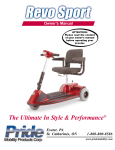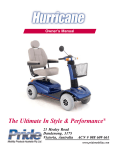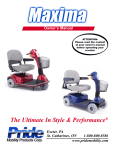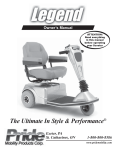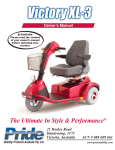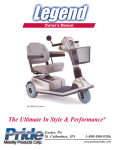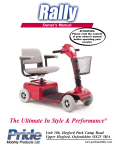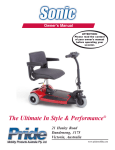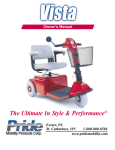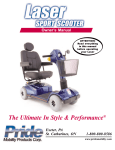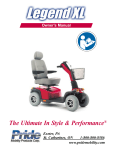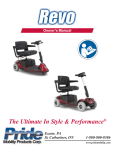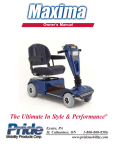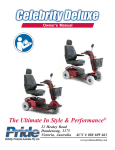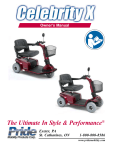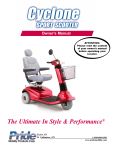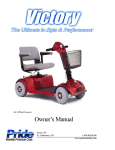Download The Ultimate In Style & Performance®
Transcript
Owner’s Manual The Ultimate In Style & Performance® 21 Healey Road Dandenong, 3175 Victoria, Australia www.pridemobility.com S A F E T Y G U I D E L I N E S Please read and follow all instructions in this owners manual before attempting to operate your Scooter for the first time. If there is anything in this manual you do not understand, or if you require additional assistance for set-up, contact your local authorized Pride provider. Using your Pride product safely depends upon your diligence in following the warnings, cautions, and instructions in this owners manual. Using your Pride product safely also depends upon your own good judgement and/or common sense, as well as that of your provider, caregiver, and/or healthcare professional. Pride is not responsible for injuries and/or damage resulting from any persons failure to follow the warnings, cautions, and instructions in this owners manual. Pride is not responsible for injuries and/or damage resulting from any persons failure to exercise good judgement and/or common sense. The symbols below are used throughout this owners manual to identify warnings and cautions. It is very important for you to read and understand them completely. WARNING! Failure to heed the warnings in this owners manual may result in personal injury. CAUTION! Failure to heed the cautions in this owners manual may result in damage to your Scooter. INFMANU1546/REV C/JULY 2002 Copyright © 2001 Pride Mobility Products Australia Pty. Ltd. 2 Cyclone C O N T E N T S I. INTRODUCTION ......................................................................................................................... 4 II. SAFETY ......................................................................................................................................... 6 III. SPECIFICATIONS ................................................................................................................... 15 IV. DESCRIPTION .......................................................................................................................... 17 V. BATTERIES AND CHARGING ............................................................................................ 23 VI. OPERATION ............................................................................................................................... 27 VII. COMFORT ADJUSTMENTS................................................................................................ 29 VIII. DISASSEMBLY AND ASSEMBLY ..................................................................................... 32 IX. OPTIONAL ACCESSORIES ................................................................................................. 35 X. BASIC TROUBLESHOOTING ............................................................................................. 36 XI. CARE AND MAINTENANCE ................................................................................................ 38 XII. WARRANTY ............................................................................................................................... 40 Cyclone 3 I . I N T R O D U C T I O N Welcome to Pride Mobility Products, Pty. Ltd. (Pride). Congratulations on the purchase of your new Pride Scooter. Your Scooter design combines the most advanced state-of-the-art components with modern, attractive styling. We are certain that the design features and trouble-free operation will add convenience to your daily living and ensure complete satisfaction. At Pride, your safety is important to us. Please read and follow all of the instructions in this manual before you attempt to operate your Scooter for the first time. These instructions were produced for your benefit. Your understanding of these instructions is essential for the safe operation of your new Pride Scooter. Pride is not liable for damage to property or personal injury arising out of the unsafe use of a Pride Scooter. Pride is also not liable for any property damage or personal injury arising out of the failure of any person and or/user to following the instructions and recommendations set forth in this manual or any other instructions or recommendations contained in other Scooter related literature issued by Pride or contained on the Pride Scooter itself. This owners manual is compiled from the latest specifications and product information available at the time of publication. We reserve the right to make changes as they become necessary. Any changes to our products may cause slight variations between the illustrations and explanations in this manual and the product you have purchased. If you experience any problems with your Scooter that you are unable to solve, or if you do not feel capable of safely following any of the instructions and/or recommendations as contained in this manual, please contact your authorised Pride provider for assistance. Once you understand how to operate and take care of your Scooter, we are certain that it will give you years of troublefree service and enjoyment. Information Exchange We want to hear your questions, comments, and suggestions about this manual. We would also like to hear about the safety and reliability of your new Pride Scooter and the service you received from your authorised Pride provider. Please notify us of any change of address so we can keep you apprised of important information about safety, new products, and new options that can increase your ability to use and enjoy your Pride Scooter. Please feel free to write us at the address below: Pride Mobility Products Australia Pty. Ltd. 21 Healey Road Dandenong, 3175 Victoria, Australia 4 Cyclone I . I N T R O D U C T I O N Pride Owners Club As a Pride product owner, you are invited to register your products warranty and enroll in the Pride Owners Club. You may do so by filling out and returning your enclosed registration card or by visiting Prides web site at www.pridemobility.com. As a registered member, each time you visit our site, you will have access to the most interactive and honest educational venue available today for people with mobility needs, their families, and friends. From our home page, click on the button that reads Owners Club to enter a page dedicated to current and potential Pride product owners. You will gain access to interviews, stories, recreation ideas, daily living tips, product and funding information, and interactive message boards. These message boards invite you to speak with other Pride customers as well as Pride representatives who are available to assist you with any questions or concerns you may have. You will receive a free gift simply for registering with the Pride Owners Club. My Authorised Pride Provider Is: Name:_______________________________________________________________________________ Address:_____________________________________________________________________________ Phone Number:________________________________________________________________________ Quick Reference Information: Scooter Model:________________________________________________________________________ Serial Number:__________________________________________________________________________ Purchase Date:________________________________________________________________________ NOTE: If you ever lose or misplace your warranty card or this owners manual, write to us and we will be glad to send you a new one immediately. Cyclone 5 I I . S A F E T Y GENERAL WARNING! Do not operate your new Scooter for the first time without completely reading and understanding this owners manual. Your Scooter is a state-of-the-art life-enhancement device designed to increase mobility. Pride provides an extensive variety of products to best fit the individual needs of the Scooter user. Please be aware that the final selection and purchasing decision regarding the type of Scooter to be used is the responsibility of the Scooter user who is capable of making such a decision and his/her healthcare professional (i.e., medical doctor, physical therapist, etc.). The contents of this manual are based on the expectation that a mobility device expert has properly fitted the Scooter to the user and has assisted the prescribing healthcare professional and/or the authorised Pride provider in the instruction process for the use of the product. There are certain situations, including some medical conditions, where the Scooter user will need to practice operating the Scooter in the presence of a trained attendant. A trained attendant can be defined as a family member or care professional specially trained in assisting a Scooter user in various daily living activities. As you begin using your Scooter during daily activities, you will probably encounter situations in which you will need some practice. Simply take your time and you will soon be in full and confident control as you maneuver through doorways, on and off elevators, up and down ramps, and over moderate terrain. Below are some precautions, tips, and other safety considerations that will help the user become accustomed to operating the Scooter safely. MODIFICATIONS Pride has designed and engineered your Scooter to provide maximum mobility and utility. A wide range of accessories is available from your Pride provider to further customize your Scooter to better suit your needs and/or preferences. However, under no circumstances should you modify, add, remove, or disable any feature, part, or function of your Scooter. WARNING! Do not modify your Scooter in any way not authorised by Pride. Unauthorised modifications may result in personal injury and/or damage to your Scooter. 6 Cyclone I I . S A F E T Y PRE-RIDE SAFETY CHECK Get to know the feel of your Scooter and its capabilities. Pride recommends that you perform a safety check before each use to make sure your Scooter operates smoothly and safely. For details on how to perform these necessary inspections, see XI. Care and Maintenance. Perform the following inspections prior to using your Scooter: n Check for proper tyre inflation. Maintain 30-35 psi in each tyre (if equipped with pneumatic tyres). n Check all electrical connections. Make sure they are tight and not corroded. n Check all controller connections to the utility tray. Make sure they are secured properly. n Check the brakes. n Check battery charge. WARNING! It is critically important that 30-35 psi tyre pressure be maintained in pneumatic tyres at all times. Failure to maintain 30-35 psi tyre pressure in pneumatic tyres at all times may result in catastrophic tyre and/or wheel failure, causing serious personal injury and/or damage to your Scooter. WARNING! Do not carry passengers on your Scooter. Carrying passengers on your Scooter may result in personal injury and/or property damage. If you discover a problem, contact your authorised Pride provider for assistance. WEIGHT LIMITATIONS Your Scooter is rated for a maximum 136-kg. weight limit. WARNING! Exceeding the weight limit voids your warranty and may result in personal injury and damage to your Scooter. Pride will not be held responsible for injuries and/or property damage resulting from failure to observe weight limitations. INCLINE INFORMATION More and more buildings have ramps with specified percents of inclination, designed for easy and safe access. Some ramps may have turning switchbacks (180-degree turns) that require you to have good cornering skills on your Scooter. n Proceed with extreme caution as you approach the downgrade of a ramp or other incline. n Take wide swings with your Scooters front wheel(s) around any tight corners. If you do that, the Scooters rear wheels will follow a wide arc, not cut the corner short, and not bump into or get hung up on any railing corners. n When driving down a ramp, keep the Scooters speed adjustment set to the slowest speed setting to ensure a safely controlled descent. See IV. Description. n Avoid sudden stops and starts. Cyclone 7 I I . S A F E T Y When climbing an incline, try to keep your Scooter moving. If you must stop, start up again slowly, and then accelerate cautiously. When driving down an incline, do so by setting the throttle control on the slowest setting and driving in the forward direction only. If your Scooter starts to move down the incline faster than you anticipated or desired, allow it to come to a complete stop by releasing the throttle control lever. Then push the throttle control lever forward slightly to ensure a safely controlled descent. WARNING! When climbing an incline, do not zigzag or drive at an angle up the face of the incline. Drive your Scooter straight up the incline. This greatly reduces the possibility of a tip or a fall. Always exercise extreme caution when negotiating an incline. WARNING! You should not travel up or down a potentially hazardous incline (i.e., areas covered with snow, ice, cut grass, or wet leaves). WARNING! When on any sort of an incline or decline, never place the Scooter in freewheel mode while seated on it or standing next to it. Handicap public access ramps are not subject to government regulation in all countries, and therefore do not necessarily share the same standard percent of slope. Other inclines may be natural or, man-made, and not designed specifically for Scooters. Figures 1 and 2 illustrate your Cyclones stability and its ability to climb grades under various weight loads and under controlled testing conditions. These tests were conducted with the Cyclones seat in the highest position and adjusted backward on the seat base to its farthest rearward position. Use this information as a guideline. Your Cyclones ability to travel up inclines is affected by your weight, your Scooters speed, your angle of approach to the incline, and your Scooter setup. 68 kg 14,1% 90 kg 12,3% 113 kg 10,5% 136 kg 8,7% FIGURE 1. MAXIMUM RECOMMENDED INCLINE ANGLE FOR THE 3 WHEEL CYCLONE 68 kg 15,8% 90 kg 14,1% 113 kg 12,3% 136 kg 10,5% FIGURE 2. MAXIMUM RECOMMENDED INCLINE ANGLE FOR THE 4 WHEEL CYCLONE WARNING! Any attempt to climb or descend a slope steeper than shown in figures 1 and 2 may put your Scooter in an unstable position and cause it to tip, resulting in personal injury. 8 Cyclone I I . S A F E T Y When you approach an incline, it is best to lean forward. See figures 3 and 4. This shifts the center of gravity of you and your Cyclone toward the front of the Scooter for improved stability. WARNING! Do not exceed the incline guidelines or any other specifications presented in this manual. FIGURE 3. NORMAL DRIVING POSITION FIGURE 4. INCREASED STABILITY DRIVING POSITION CORNERING INFORMATION Excessively high cornering speeds can create the possibility of tipping. Factors which affect the possibility of tipping include, but are not limited to, cornering speed, steering angle (how sharply you are turning), uneven road surfaces, inclined road surfaces, riding from an area of low traction to an area of high traction (such as passing from a grassy area to a paved area especially at high speed while turning), and abrupt directional changes. High cornering speeds are not recommended. If you feel that you may tip over in a corner, reduce your speed and steering angle (i.e., lessen the sharpness of the turn) to prevent your Scooter from tipping. WARNING! Do not attempt to corner sharply at high speeds. When cornering sharply, reduce your speed. When using your Scooter at higher speeds, do not corner sharply. This greatly reduces the possibility of a tip or fall. To avoid personal injury or property damage, always exercise common sense when cornering. Cyclone 9 I I . S A F E T Y BRAKING INFORMATION Your Scooter is equipped with two powerful brake systems: 1. Regenerative: Uses electricity to rapidly slow the vehicle when the throttle control lever returns to the center/ stop position; and 2. Disc Park Brake: Activates mechanically after regenerative braking slows the vehicle to near stop, or when power is removed from the system for any reason. Brake engagement is far more abrupt at higher speeds. It is important that you know when the brakes will engage, and that you are braced for the resulting deceleration. WARNING! Your Scooter can decelerate very quickly. Do not decelerate or turn abruptly when traveling at high speed unless absolutely necessary. If it is absolutely necessary to decelerate or turn abruptly when traveling at high speed, brace yourself by gripping the tiller tightly and planting your feet firmly against the floorboard. Users who cannot grip the tiller tightly and/or plant their feet firmly against the floorboard should avoid decelerating from or turning abruptly at high speed, and therefore should avoid traveling at high speed. Serious personal injury and property damage can result from falling forward as your Scooter decelerates quickly unless you brace yourself firmly. OUTDOOR DRIVING SURFACES Your Scooter is designed to provide optimum stability under normal driving conditionsdry, level surfaces composed of concrete, blacktop, or asphalt. However, Pride recognizes that there will be times when you will encounter other surface types. For this reason, your Scooter is designed to perform admirably on packed soil, grass, and gravel. Feel free to use your Scooter safely on lawns and in park areas. n n n n Reduce your Scooters speed when driving on uneven terrain and/or soft surfaces. Avoid tall grass that can become tangled in the running gear. Avoid loosely packed gravel and sand. If you feel unsure about a driving surface, avoid that surface. STATIONARY OBSTACLES (STEPS, KERBS, ETC.) Proceed with extreme caution when driving near raised surfaces, unprotected ledges and/or drop-offs (kerbs, porches, stairs, etc.). WARNING! Do not attempt to have your Scooter climb or descend an obstacle that is inordinately high. Serious personal injury and/or damage may result. WARNING! Do not attempt to have your Scooter proceed backwards down any step, kerb, or other obstacle. This may cause the Scooter to tip and cause personal injury. 10 Cyclone I I . S A F E T Y PUBLIC ROADS AND PARKING LOTS WARNING! You should not operate your Scooter on public streets and roadways. Be aware that it may be difficult for traffic to see you when you are seated on your Scooter. Obey all local pedestrian traffic rules. Wait until your path is clear of traffic, and then proceed with extreme caution. NOTE: Safety accessories like reflectors, fluorescent flags, and various lighting packages are available to order from your authorised Pride provider. INCLEMENT WEATHER PRECAUTIONS WARNING! Pride recommends that you do not operate your Scooter in icy or slippery conditions or on salted surfaces (i.e., walks or roads). Such use may result in an accident, personal injury, or adversely affect the performance and safety of your Scooter. WARNING! Pride recommends that you do not expose your Scooter to any type of moisture at any time (rain, snow, mist, or wash). Such exposure can damage your Scooter. Never operate your Scooter if it has been exposed to moisture until it has dried thoroughly. FREEWHEEL MODE Your Scooter is equipped with a freewheel lever that when pulled up allows the Scooter to be pushed. For more information about how to place your Scooter into and out of freewheel mode, see IV. Description. WARNING! Do not use your Scooter in freewheel mode without an attendant present. Personal injury may result. WARNING! Do not attempt to personally place your Scooter in freewheel mode while seated on it. Personal injury may result. Ask an attendant for assistance if necessary. WARNING! Do not place your Scooter in freewheel mode while on an incline. The Scooter could roll uncontrollably on its own, causing personal injury. TYRE INFLATION If your Scooter is equipped with pneumatic tyres, you should check or have the air pressure checked at least once a week. Proper inflation pressures will prolong the life of your tyres and help ensure the smooth operation of your Scooter. WARNING! It is critically important that pneumatic tyres be inflated to 30-35 psi. Do not underinflate or overinflate your tyres. Improper tyre pressure may result in catastrophic tyre and/or wheel failure. Serious personal injury and/or property damage may result. WARNING! Inflate your Scooter drive tyres from a regulated air source with an available pressure gauge. Minimum air pressure for Scooter drive tyres is 30-35 psi. Inflating your tyres from an unregulated air source could overinflate them, resulting in a burst tyre and/or personal injury. Cyclone 11 I I . S A F E T Y STAIRS AND ESCALATORS Scooters are not designed to travel up or down stairs or escalators. Always use an elevator. WARNING! Do not use your Scooter to negotiate steps or escalators. You may cause injury to yourself and to others and damage your Scooter. DOORS n Determine if the door opens toward or away from you. n Use your hand to turn the knob or push the handle or push-bar. n Drive your Scooter gently and slowly forward to push the door open. Or drive your Scooter gently and slowly backwards to pull the door open. ELEVATORS Modern elevators have a door edge safety mechanism that, when pushed, reopens the elevator door(s). n If you are in the doorway of an elevator when the door(s) begin to close, push on the rubber door edge or allow the rubber door edge to contact the Scooter and the door will reopen. n Use care that pocketbooks, packages, or Scooter accessories do not become caught in elevator doors. LIFT/ELEVATION PRODUCTS If you will be traveling with your Scooter, you may find it necessary to use a lift/elevation product to aid in transportation. Pride recommends that you closely review the instructions, specifications, and safety information set forth by the manufacturer of the lift/elevation product before using that product. BATTERIES In addition to following the warnings below, be sure to comply with all other battery handling information. For more information about your Scooters batteries, see V. Batteries and Charging. WARNING! Scooter batteries weigh 11 kg (32 AH) or 14 kg (40) each. If you are unable to lift that much weight, be sure to get help. Lifting beyond your capacity can result in personal injury. WARNING! Battery posts, terminals, and related accessories contain lead and lead compounds. Wash hands after handling. WARNING! Always protect the batteries from freezing and never charge a frozen battery. Charging a frozen battery may result in personal injury and/or damage to the battery. PREVENTING UNINTENDED MOVEMENT WARNING! If you anticipate being seated in a stationary position for an extended period of time, turn off the power. This will prevent unexpected motion from inadvertent throttle control lever contact. Failure to do so may result in personal injury. 12 Cyclone I I . S A F E T Y MOTOR VEHICLE TRANSPORT Currently, there are no standards approved for tie-down systems in a moving vehicle of any type to transport a person while seated in a Scooter. Although your Scooter may be equipped with a positioning belt, this belt is not designed to provide proper restraint during motor vehicle transport. Anyone traveling in a motor vehicle should be properly secured in the motor vehicle seat with safety belts securely fastened. WARNING! Do not sit on your Scooter while it is in a moving vehicle. Personal injury and/or property damage may result. WARNING! Always be sure your Scooter and its batteries are properly secured when it is being transported. Failure to do so may result in personal injury and/or damage to your Scooter. GETTING ONTO AND OFF OF YOUR SCOOTER Getting onto and off of your Scooter requires a good sense of balance. Please observe the following safety tips when getting onto and off of your Scooter: n n n n Power down your Scooter. See VI. Operation. Ensure that your Scooter is not in freewheel mode. See IV. Description. Make certain that the seat is locked into place and the key is removed from the key switch. The seat armrests can be flipped up to make getting on and off the Scooter easier. WARNING! Position yourself as far back as possible in the Scooter seat to prevent the Scooter from tipping and causing injury. WARNING! Avoid using your armrests for weight bearing purposes. Such use may cause the Scooter to tip and cause personal injury. WARNING! Avoid putting all of your weight on the floorboard. Such use may cause the Scooter to tip and cause personal injury. POSITIONING BELTS Your authorised Pride provider, therapist(s), and other healthcare professionals are responsible for determining your requirement for a positioning belt in order to operate your Scooter safely. WARNING! If you require a positioning belt to safely operate your Scooter, make sure it is fastened securely. Serious personal injury may result if you fall from the Scooter. Cyclone 13 I I . S A F E T Y REACHING AND BENDING Avoid reaching or bending while driving your Scooter. When reaching, bending, or leaning while seated on your Scooter, it is important to maintain a stable center of gravity and keep the Scooter from tipping. Pride recommends that the Scooter user determine his/her personal limitations and practice bending and reaching in the presence of a qualified healthcare professional. WARNING! Do not bend, lean, or reach for objects if you have to pick them up from the floor by reaching down between your knees. Movements such as these may change your center of gravity and the weight distribution of the Scooter and cause your Scooter to tip, possibly resulting in personal injury. Keep your hands away from the tyres when driving. PRESCRIPTION DRUGS/PHYSICAL LIMITATIONS The Scooter user must exercise care and common sense when operating his/her Scooter. This includes awareness of safety issues when taking prescribed or over-the-counter drugs or when the user has specific physical limitations. WARNING! Consult your physician if you are taking prescribed or over-the-counter medication or if you have certain physical limitations. Some medications and limitations may impair your ability to operate your Scooter in a safe manner. ALCOHOL The Scooter user must exercise care and common sense when operating his/her Scooter. This includes awareness of safety issues while under the influence of alcohol. WARNING! Do not operate your Scooter while you are under the influence of alcohol, as this may impair your ability to drive safely. REMOVABLE PARTS WARNING! Do not attempt to lift or move a Scooter by any of its removable parts. Personal injury and damage to the Scooter may result. 14 Cyclone I I I . S P E C I F I C AT I O N S 67 - 73 cm Adjustable 122- 132 cm 20 - 30 cm 90˚,100˚ 102˚,105˚ 42 - 52 cm 9 cm FIGURE 5. CYCLONE DIMENSIONS 4 Wheel Length 3 Wheel Length 48 cm 131 cm 127 cm 44 cm 122 cm 61- 73 cm 3 Wheel Turning Radius 162,5 cm 4 Wheel Turning Radius 61 cm Cyclone 15 I I I . Model Numbers Length Width Tires Weight Capacity Battery Type Horsepower Charger Speed (max) Maximum Grade Range, Maximum Turning Radius Body Colors Seating S P E C I F I C AT I O N S Three-wheel: SPSC4000AUSCRED (Candy Apple Red), SPSC4000AUSVBLU (Viper Blue), SPSC4000AUSFGRE (Forest Green), SPSC4000AUSOBLK (Onyx Black), Four-wheel: SPSC4400AUSCRED, SPSC4400AUSVBLU, SPSC4400AUSFGRE, SPSC4400AUSOBLK 127 cm (3 wheel), 131 cm (4 wheel) 61 cm Type: Pneumatic; Front: 8 cm x 25,5; Rear: 10 cm x 25,5 cm 136 kg Maximum Two 12-volt, 32 AH, U-1 type, SLA (sealed lead-acid) or two 12 volt, 40 AH, SLA 2 hp (peak) Onboard 3-amp charger Variable up to 8,4 km/hr (12 km/hr with Turbo mode) Variable (refer to figures 1 and 2) (12V, 40 AH batteries) Up to 32-49 km (12V, 32 AH batteries) Up to 32-40 km 3 wheel: 122 cm; 4 wheel: 162,5 cm Painted: Candy Apple Red, Viper Blue, Forest Green, and Onyx Black Standard Option Seating Style: Sport Scooter high back with headrest and sliders mounted on a standard seat post Standard Seating Features: • Adjustable armrest height, width, and angle • Four adjustable seatback angles • Five position seat height adjustment Dimensions: 48 cm width x 44 cm depth (usable) x 67 cm - 73 cm height (usable) Material: Armrests: Vinyl: Grey, Beige, Black Fabric: Grey, Gold Upholstered, matching vinyl or fabric with cosmetic edge guards Adjustable seat height from scooter deck: variable between 42 cm to 52 cm Included Features Brakes Rear Wheel Drive Wheels Tiller Type Freewheel Mechanism Availability Weight of Scooter Front-to-Rear Lockup Ground Clearance Accessories 16 Full directional lighting package with front “running lights”; deluxe motorcycle-style rearview mirror (can be installed on left or right side of tiller); lighted touch pad control console; front basket; user adjustable sliding seat; full “soft-ride” shock absorber-equipped suspension; four-position adjustable seat-back angle; adjustable armrest width, height & angle; dual microprocessor-based motor controller system; modular controller/charger assembly; infinitely adjustable tiller with auto-leveling console and shock dampening action; standard front & rear integrated bumpers; easily accessible charger port receptacle, circuit breaker and freewheel lever; standard non-marring, high density polyurethane bumper(s); battery well accepts 32AH or 40AH batteries; standard battery fixation straps; diagnostic beep codes; Turbo function; speed control technology (SCT); brushless motor/controller Electronic disc, manual freewheel Sealed Transaxle - 24V Pride Micro-Mag aluminum alloy wheels in red/black/or gold Infinitely adjustable with auto-leveling console Lever at lower right portion of rear shroud TOTAL Weight of Cyclone (with two 12V, 40AH batteries) = 96 kg (3 wheel); 103 kg (4 wheel) TOTAL Weight of Cyclone (with two 12V, 32AH batteries) = 90 kg (3 wheel); 97 kg (4 wheel) Component breakdown: Front section: 20,5 kg (3 wheel), 28 kg (4 wheel) Rear section (without batteries or rear shroud): 29 kg Rear plastic shroud: 1,8 kg Seat: 18,5 kg Batteries (note: two batteries are required per Scooter): 12V, 40 AH 14 kg (each) 12V, 32 AH 11 kg (each) Basket: 0,6 kg Dual lock pins & camlock levers 9 cm Rear basket; cup holder; portable canopy; safety flag; lap belt Cyclone I V. D E S C R I P T I O N Your Cyclone is a motorized electric Sport Scooter meant for indoor/outdoor use. The Scooter is designed to travel primarily on smooth surfaces such as pavement, roads, parking lots, floors, and driveways. For easy transportation or storage, you can disassemble your Cyclone into seven components. See figure 6. FRONT SECTION SEAT REAR SECTION REAR SHROUD BATTERIES FIGURE 6. CYCLONE COMPONENTS BASKET CONTROL CONSOLE ASSEMBLY The control console assembly houses all of the controls you need to drive your Cyclone, including the speed adjustment buttons, throttle control levers, battery condition LED, maximum speed LED, on/off indicator LED, clock, running lights button, headlight button, headlight status LED, horn buttons, turn indicator buttons, hazard light button, Turbo button, and the Turbo ready indicator LED. See figure 7. MAXIMUM SPEED LED BATTERY CONDITION LED SPEED ADJUSTMENT BUTTON HAZARD LIGHT BUTTON TURBO READY INDICATOR LED RUNNING LIGHTS BUTTON LEFT TURN INDICATOR BUTTON TURBO BUTTON HEADLIGHT STATUS LED HEADLIGHT BUTTON RIGHT TURN INDICATOR BUTTON HORN BUTTON HORN BUTTON THROTTLE CONTROL LEVER (REVERSE) FIGURE 7. CONTROL CONSOLE ASSEMBLY Cyclone CLOCK SPEED ADJUSTMENT BUTTON THROTTLE CONTROL LEVER (FORWARD) ON/OFF INDICATOR LED 17 I V. D E S C R I P T I O N WARNING! Do not expose the control console assembly to moisture. In the event that the console does become exposed to moisture, do not attempt to operate your Cyclone until the console has thoroughly dried. Key Switch (not shown) n Fully insert the key into the key switch and turn it clockwise to power up (turn on) your Cyclone. WARNING! If the key is moved to the off position while your Cyclone is in motion, the electronic brakes engage and your Cyclone comes to an abrupt stop! n Turn the key counterclockwise to power down (turn off) your Cyclone. Speed Adjustment Buttons These adjustment buttons enable you to pre-select and limit your Cyclones top speed. n Press the image of the tortoise to decrease the Cyclones pre-selected maximum speed. n Press the image of the hare to increase the Cyclones pre-selected maximum speed. Maximum Speed LED The LED lights up to display the maximum speed you have pre-selected with the speed adjustment buttons. NOTE: The more green bars that are lit on the maximum speed LED, the faster your pre-selected maximum speed will be. Throttle Control Lever This lever allows you to control the forward speed and the reverse speed of your Cyclone up to the maximum speed you pre-select with the speed adjustment buttons. n Place your right hand on the right handgrip and your left hand on the left handgrip. n Use your right thumb to push the right side of the lever to disengage your Cyclones brakes and move forward. n Release the lever and allow your Cyclone to come to a complete stop before pushing the other side of the lever to move in reverse. n When the throttle control lever is completely released, it automatically returns to the center stop position and engages your Cyclones brakes. Battery Condition LED When the key is turned to the on position, this LED gives an approximate reading of your Cyclones battery voltage level. n Green indicates the Cyclones batteries are fully charged. n Yellow indicates that the Cyclones battery voltage level is getting low and will require a charge soon. n Red indicates that your Cyclones battery voltage level is very low, and the batteries should be recharged as soon as possible. Running Lights Button This button controls your Cyclones running lights. n Press the button once to turn on your Cyclones running lights. n Press the button again to turn off your Cyclones running lights. Headlight Status LED The green LED will light when your Cyclones headlight is turned on. 18 Cyclone I V. D E S C R I P T I O N Headlight Button If more light is needed in addition to the running lights, use the headlight. NOTE: In order for the headlight to work, you must first have the running lights on. n Press the button once to turn on the Cyclones headlight. n Press the button again to turn off the Cyclones headlight. Horn Button The key must be inserted and turned to the on position for the horn to be operational. n This button activates a warning horn. n Do not hesitate to use the warning horn when its use could prevent accident or injury. Hazard Light Button This button activates the 4-way yellow flashers on your Sport Scooter. n Press the button once to turn on the flashers. n Press the button again to turn off the flashers. Turn Indicator Buttons n Press the appropriate turn indicator button once to activate it. n Your Cyclones turn indicators are timed to shut off automatically. On/Off Indicator LED When the key of the Cyclone is turned to the on position, the green on/off indicator LED will light to indicate that your Cyclone is powered up (on). Clock NOTE: For safe shipping, the clock is packed separately. Remove the clock from its packing, set the time (see below), then insert it into its place in the control console assembly. See figure 7. Setting the Time The time is set in the same manner as a wristwatch. n Pull the crown out. n Rotate the crown to set the time, then push the crown back in. Battery Removal and Replacement NOTE: If you dont feel confident in replacing the clock battery, please take the clock to any watch retailer to perform this service. 1. Remove the clock from the control console assembly. 2. Remove the rear cover of clock. 3. Remove the battery from the clock. 4. Replace the clock battery with type SR626SW. Batteries can be purchased at a retail outlet. 5. Place a new battery (+ sign up) in the battery compartment. 6. Replace the battery compartment lid. Cyclone 19 I V. D E S C R I P T I O N TURBO FUNCTION The Turbo mode provides the option of increasing the Sport Scooter speed up to 12 km/hr by simply pressing and holding in the Turbo button while driving a straight course on flat and smooth terrain. This beneficial feature allows the user to travel greater distances in less time as compared to the conventional Sport Scooter speed mode. The Turbo function will engage whenever the maximum speed LED is lit to more than 3/4 of the Sport Scooters top speed when the throttle control lever is fully depressed. When the Turbo button is released, the Sport Scooter then returns to the normal maximum Sport Scooter speed mode speed of approximately 8 km/hr (depending upon where the maximum speed LED is set). WARNING! In the event the Turbo button sticks or malfunctions when you try to use it, Pride recommends that you release the throttle control lever to stop your Sport Scooter. Set the speed adjustment buttons to under 3/4 full speed to disable the Turbo feature, then notify your authorised Pride provider immediately. WARNING! Your Sport Scooters Turbo mode has been engineered to function safely while driving a straight course on flat and smooth terrain. To eliminate the possibility of injury, Pride recommends that you adhere to the following rules for engaging and disengaging the Turbo mode. n n n n Do not press the Turbo button while turning the Sport Scooter. Do not press the Turbo button while driving on inclines or declines of any type. Do not press the Turbo button while driving on uneven, bumpy terrain. Release the Turbo button before entering a turn, an incline, decline, or uneven terrain of any type. Turbo Ready Indicator LED The yellow Turbo ready indicator LED illuminates when the Sport Scooter is in Turbo Ready mode. The Turbo function will become inactive (yellow indicator will turn off) and the vehicle speed will decrease (to the speed preset with the speed adjustment buttons) whenever: n the Sport Scooter is descending an incline exceeding approximately 14.1%. n the Sport Scooter is driven on a lateral bank (leftward or rightward incline) exceeding approximately 14.1%. n the Sport Scooter is steered more than one-eighth (1/8) of a turn to the left or the right (i.e., approximately over the 11 oclock or 1 oclock positions when seated on the Sport Scooter). SPEED CONTROL TECHNOLOGY (SCT) The Cyclone Sport Scooter features our exclusive patent-pending Speed Control Technology (SCT ) as an added safeguard. SCT senses incline conditions and vehicle direction through its four sensors to automatically disable the Turbo mode during cornering, steep descents, or extreme lateral banking. This provides the user the added confidence of knowing that his/her driving skills are supplemented by a state-of-the-art system that reduces speed in situations that require greater caution. NOTE: The additional margin of safety provided by SCT should only be considered a supplement to safe driving habits and thorough practice in operating the Sport Scooter in strict compliance with all conditions outlined in this owners manual. 20 Cyclone I V. D E S C R I P T I O N REAR SECTION The onboard battery charger (not shown), the charger power lead receptacle, the batteries (not shown), the electronics module, the main circuit breaker (reset button), the ammeter, the manual freewheel lever, the anti-tip wheels, and the motor/transaxle assembly (not shown) are located on the rear section of your Cyclone. See figure 8. Refer to VIII. Disassembly and Assembly for instructions on removing the rear shroud. RUNNING LIGHT LIGHT BULB RUNNING LIGHT FUSE CHARGER POWER LEAD STORAGE COMPARTMENT TURN INDICATOR FUSE AMMETER MAIN CIRCUIT BREAKER (RESET BUTTON) ELECTRONICS MODULE TURN INDICATOR LIGHT BULB LIGHT COVER MANUAL FREEWHEEL LEVER ANTI-TIP WHEEL FUSES CHARGER POWER LEAD RECEPTACLE FIGURE 8. REAR SECTION (LEFT LIGHT COVER REMOVED FOR CLARITY) Batteries (not shown) The batteries store the electrical energy that powers your Cyclone. See V. Batteries and Charging. Main Circuit Breaker (reset button) When the voltage in your Cyclones batteries becomes low or your Cyclone is heavily strained because of excessive loads or steep inclines, the main circuit breaker may trip to protect your Cyclones motor and electronics from damage. See figure 8. n The main circuit breaker reset button pops out when the breaker trips. n When the breaker trips, the entire electrical system of your Cyclone shuts down. n Allow a minute or two for your Cyclones electronics to rest. n Push in the reset button to reset the breaker. n If the breaker trips frequently, you may need to charge your batteries more often. You may also need to have your authorised Pride provider perform a load test on your Cyclones batteries. n If the main circuit breaker trips repeatedly, see your authorised Pride provider for service. Cyclone 21 I V. D E S C R I P T I O N Manual Freewheel Lever Whenever you need or want to push your Cyclone for short distances, you can put it in manual freewheel mode. WARNING! Before placing your Cyclone into or taking it out of freewheel mode, make certain that the key is removed from the key switch. Even though the motor of your Cyclone is disengaged from the drive system when your Sport Scooter is put in manual freewheel mode, the motor can still run if the throttle lever is pushed. Never sit on a Sport Scooter when it is in freewheel mode. Never put a Sport Scooter in freewheel mode on any incline. n The manual freewheel lever is located on the end of the motor/transaxle assembly at the right rear of the Cyclone. See figure 8. n Pull up on the manual freewheel lever to disable the drive system and the brake system. n You may now push your Cyclone. n Push down on the manual freewheel lever to take your Cyclone out of freewheel mode, and reengage the drive and brake systems. Motor/Transaxle Assembly (not shown) The brushless motor/transaxle assembly is an electromechanical unit that converts the electrical energy of your Cyclones batteries into controlled mechanical energy that drives the Cyclones wheels. Anti-Tip Wheels The anti-tip wheels are an integral and important safety feature of your Cyclone. Do not, under any circumstances, remove the anti-tip wheels from your Cyclone. See figure 8. Charger Power Lead Receptacle The charger power lead plugs into your Cyclones battery charger by means of the charger power lead receptacle. Fuses The fuses help protect your Cyclones lighting, control console assembly, and charging systems from receiving an overload of electrical current. The fuses used in the Cyclone are the same type used in modern automobiles. If a fuse must be replaced (see figures 9 and 10), use only the specified amp fuse. For more information on replacing a fuse, see XI. Care and Maintenance. FIGURE 9. WORKING FUSE FIGURE 10. BLOWN FUSE (REPLACE) WARNING! Failure to use properly rated fuses may cause damage to the Cyclones electrical system and may result in personal injury. 22 Cyclone V. BAT T E R I E S AND CHARGING Your Cyclone requires two long-lasting, 12-volt, deep-cycle batteries that are sealed and maintenance free. They are recharged by an onboard 3-amp charging system. n Charge your Cyclones batteries prior to using it for the first time. n Keep the batteries fully charged to keep your Sport Scooter running smoothly. READING YOUR BATTERY VOLTAGE The battery condition LED on the control console assembly indicates the approximate strength of your batteries using a color coded LED. See figure 11. Green indicates fully charged batteries, yellow a draining charge, and red indicates that an immediate recharge is necessary. To check the charge, you must first unplug the charger power lead and power up your Sport Scooter. You can also check the charge by the ammeter, located on the electronics module. The charger power lead must be plugged into a standard wall outlet in order to obtain a reading. When the amperage reading is at or near zero (0) amps, charging is complete. See figure 12. FIGURE 11. BATTERY CONDITION LED FIGURE 12. AMMETER INDICATES BATTERY IS FULLY CHARGED CHARGING YOUR BATTERIES Follow these easy steps to charge your batteries safely: 1. Position your Sport Scooter close to a standard wall outlet. 2. Remove the key from the key switch. 3. Make certain that the freewheel lever is in the drive (down) position. 4. Plug the charger power lead into the charger power lead receptacle on your Sport Scooter. 5. Extend the charger power lead and plug it into the wall outlet. It is recommended that you charge your batteries for 8 to 14 hours. WARNING! Never use an extension lead to plug in your battery charger. Plug the charger directly into a properly wired standard wall outlet. 6. When the batteries are fully charged, unplug the charger power lead from the wall outlet and then from the charger power lead receptacle. NOTE: There is a charger inhibit function on your Sport Scooter. The Sport Scooter will not run and the battery condition LED meter will not operate while the batteries are charging. Cyclone 23 V. BATTERIES AND CHARGING FREQUENTLY ASKED QUESTIONS (FAQS) How does the charger work? When your Cyclones battery voltage is low, the charger works harder, sending more electrical current to the batteries to bring up their charge. As the batteries approach a full charge, the charger sends less and less electrical current. When the batteries are fully charged, the current sent from the charger is at nearly zero amperage. Therefore, when the charger is plugged in, it maintains the charge on your Cyclones batteries, but does not overcharge them. We do not recommend that you charge your Cyclones batteries for more than 24 consecutive hours. What if my Cyclones batteries wont charge? n Ensure that the battery cables are connected properly. n Ensure that both ends of the charger power lead are inserted fully. n Examine the 5-amp charger fuse. If the fuse is blown, the batteries will not charge. See figures 9 and 10. Can I use a different charger? For the safest, most efficient, and balanced charging of your Cyclones batteries, we prefer and highly recommend simultaneous charging of both batteries with the onboard battery charger. How often must I charge the batteries? Two major factors must be considered when deciding how often to charge your Cyclones batteries: n All day Sport Scooter use on a daily basis. n Infrequent or sporadic Sport Scooter use. With these considerations in mind, you can determine how often and for how long you should charge your Cyclones batteries. We designed the onboard charger so that it will not overcharge your Sport Scooters batteries. However, you may encounter some problems if you do not charge your batteries often enough and if you do not charge them on a regular basis. Following the five guidelines below will provide safe and reliable battery operation and charging. n If you use your Cyclone daily, charge its batteries as soon as you finish using it for the day. Your Cyclone will be ready each morning to give you a full day of service. We recommend that you charge your Cyclones batteries for 8 to 14 hours after daily use. n If you use your Cyclone once a week or less, charge its batteries at least once a week for 12 to 14 hours at a time. n Keep your Cyclones batteries fully charged. n Avoid deeply discharging your Cyclones batteries. n Do not charge your Cyclones batteries for more than 24 consecutive hours. 24 Cyclone V. BAT T E R I E S AND CHARGING How can I get maximum range or distance per charge? Rarely will you have ideal driving conditionssmooth, flat, hard driving surfaces with no wind or curves. Often, you will face hills, pavement cracks, uneven and loosely packed surfaces, curves, and wind, all of which affect the distance or running time per battery charge. How often the Turbo button is used also affects your overall battery range. Below are a few suggestions for obtaining the maximum range per battery charge. n Always fully charge your Cyclones batteries prior to daily use. n Maintain 30-35 psi (pounds per square inch) in each tyre. n Plan your route ahead to avoid as many hills, cracked, broken, or soft surfaces as possible. n Limit your baggage weight to essential items. n Try to maintain an even speed while your Cyclone is in motion. n Avoid stop-and-go driving. What type and size of battery should I use? We recommend deep-cycle batteries that are sealed and maintenance free. Both sealed lead-acid and gel cell are deep-cycle batteries that are similar in performance. Do not use wet-cell batteries, which have removable caps. CAUTION! Do not remove the caps from sealed batteries. Water cannot be added to sealed batteries. Cap removal voids the battery warranty and may cause damage to the batteries and to your Cyclone. Use these specifications to reorder deep-cycle batteries: Type: Deep-cycle (sealed lead-acid or gel cell) Size: U-1 (32 AH only); or 40 AH Voltage: 12-volts each Amperage: 32 AH or 40 AH (amp hours) To change a battery in your Cyclone: WARNING! Battery posts, terminals, and related accessories contain lead and lead compounds. Wash hands after handling. 1. 2. 3. 4. 5. 6. 7. 8. 9. 10. 11. Remove the seat and the rear shroud. See VIII. Disassembly and Assembly. Disconnect the battery tie-down straps (if so equipped). Disconnect the battery cables from the electronics module. Disconnect the battery cables from the battery terminals. Remove the old battery. Place a new battery in the battery well. Connect the red battery cable to the positive (+) battery terminal. Connect the black battery cable to the negative (-) battery terminal. Reconnect the battery cables to the electronics module. Reconnect the battery tie-down straps (if so equipped). Reinstall the rear shroud and the seat. Why do my new batteries seem weak? Deep-cycle batteries employ a different chemical technology than that used in car batteries, nickel-cadmium batteries (nicads), and other common battery types. Deep-cycle batteries are specifically designed to provide power, drain down their charge, and then accept a relatively quick recharge. Cyclone 25 V. BATTERIES AND CHARGING Pride works closely with our battery manufacturer to provide batteries that best suit your Cyclones specific electrical demands. Fresh batteries arrive daily at Pride and are shipped fully charged to our customers. During shipping, the batteries may encounter temperature extremes that can influence their initial performance. Heat diminishes the charge on the battery; cold slows the available power and extends the time needed to recharge the battery. It may take a few days for the temperature of your Cyclones batteries to stabilize and adjust to their new room or ambient temperature.More importantly, it takes a few charging cycles (partial draining followed by full recharging) to establish the critical chemical balance that is essential to a deep-cycle batterys peak performance and long life. Follow these steps to properly break-in your Cyclones new batteries for maximum efficiency and service life. 1. Fully recharge any new battery prior to its initial use. This charging cycle brings the battery up to about 88% of its peak performance level. 2. Operate your new Cyclone in familiar and safe areas. Drive slowly at first, and do not travel too far from your home or familiar surroundings until you have become accustomed to your Cyclones controls and have properly broken in your Sport Scooters batteries. 3. Fully recharge the batteries. They should be at over 90% of their peak performance level. 4. Operate your Cyclone again. 5. Fully recharge the batteries again. 6. After four or five charging cycles, the batteries are able to receive a charge of 100% of their peak performance level and are able to last for an extended period of time. How can I ensure maximum battery life? Fully charged deep-cycle batteries provide reliable performance and extended battery life. Keep your Cyclones batteries fully charged whenever possible. Batteries that are regularly and deeply discharged, infrequently charged, or stored without a full charge may be permanently damaged, causing unreliable performance and limited service life. How should I store my Cyclone and its batteries? If you plan on not using your Cyclone for an extended period of time, it is best to: n Fully charge its batteries prior to storage. n Disconnect the battery harnesses from the electronics module. n Store your Cyclone in a warm, dry environment. n Avoid storing your Cyclone where it will be exposed to temperature extremes. WARNING! If your Cyclones batteries do become frozen, do not attempt to charge them. Cold or frozen batteries should be allowed to warm up for several days prior to recharging. For prolonged storage, you may wish to place several boards under the frame of your Cyclone to raise the Sport Scooter off of the ground. This takes the weight off the tyres and reduces the possibility of flat spots developing on the areas of the tyres contacting the ground. What about public transportation? If you intend to use public transportation with your Sport Scooter, you must contact the transportation provider in advance to determine their specific requirements. 26 Cyclone V I . O P E R AT I O N BEFORE GETTING ON YOUR CYCLONE n Have you fully charged the batteries? See V. Batteries and Charging. n Is the manual freewheel lever in the drive (down) position? Never leave the manual freewheel lever pulled up unless you are manually pushing your Cyclone. GETTING ON YOUR CYCLONE 1. Make certain that the key is removed from the key switch. 2. Stand at the side of your Cyclone. 3. Push down on the seat rotation lever and rotate the seat until it is facing you. 4. Make certain that the seat is locked securely in position. 5. Position yourself comfortably and securely in the seat. 6. Push down on the seat rotation lever and rotate the seat until you are facing forward. 7. Make certain that the seat is locked securely in position. 8. Make certain that your feet are safely on the floorboard. PRE-RIDE ADJUSTMENTS AND CHECKS n Are you positioned comfortably in the seat? See Getting On Your Cyclone, above. n Is the seat at the proper height? See VII. Comfort Adjustments. n Is the seat locked securely in place? See VII. Comfort Adjustments. n Is the tiller handle at a comfortable setting and locked securely in place? See VII. Comfort Adjustments. n Is the key fully inserted into the key switch and in the on position? See IV. Description. n Is the maximum speed LED set to a slow setting? See IV. Description. n Are you grasping the handgrips with a thumb resting on each side of the throttle control lever? See IV. Description. n Is the Turbo ready indicator LED working? n While the Scooter is stationary, turn the tiller to more than one-eighth (1/8) of a turn to the left and right the Turbo ready indicator LED should not be lit when in these positions. n Return the tiller to the center (straight ahead) position the Turbo ready indicator LED should illuminate. n Does your Cyclones horn work properly? n Is your proposed path clear of people, pets, and obstacles? n Have you planned your route to avoid adverse terrain and as many inclines as possible? OPERATING YOUR CYCLONE After planning your route: n Adjust the maximum speed LED on the control console assembly to your desired speed. n Press your thumb against the appropriate throttle control lever. n The electric brake automatically disengages and the Cyclone accelerates smoothly to the speed you preselected with the speed adjustment buttons, which is displayed on the maximum speed LED. Cyclone 27 V I . O P E R AT I O N WHETHER YOU ARE DRIVING FORWARD OR IN REVERSE n Pull on the left handgrip to steer your Cyclone to the left. n Pull on the right handgrip to steer your Cyclone to the right. n Move the tiller to the center position to drive straight ahead. n Release the throttle control lever to decelerate and come to a complete stop. n The electric brake automatically engages when your Cyclone comes to a stop. NOTE: The rear-wheel drive transaxle gives your Cyclone maximum traction with minimal steering effort on your part. GETTING OFF OF YOUR CYCLONE 1. Bring your Cyclone to a complete stop. 2. Make certain that the key is turned (counterclockwise) to the off position. 3. Pull up on the seat rotation lever and rotate the seat until you are facing toward the side of your Cyclone. 4. Make certain that the seat is locked securely in position. 5. Carefully and safely get out of the seat and stand to the side of your Cyclone. 6. You may leave the seat facing to the side to facilitate boarding your Cyclone the next time you plan to operate it. 28 Cyclone VII. COMFORT ADJUSTMENTS TILLER ANGLE ADJUSTMENT WARNING! Remove the key from the key switch before adjusting the tiller. Never attempt to adjust the tiller while the Scooter is in motion. Your Cyclone is equipped with an ergonomically enhanced pivoting tiller that keeps the console controls at your fingertips regardless of the tiller angle. 1. Pull up on the tiller adjustment lever. See figure 13. 2. Move the tiller to a comfortable position. 3. Release the tiller adjustment lever. The tiller will remain in the position you selected. NOTE: In order to lower the tiller to the Scooter deck, you must first remove the seat, rear shroud, and both batteries. See VIII. Disassembly and Assembly. TILLER ADJUSTMENT LEVER SEAT HEIGHT ADJUSTMENT FIGURE 13. TILLER ADJUSTMENT The seat can be repositioned to one of five different heights. 1. Remove the seat from your Cyclone. See VIII. Disassembly and Assembly. SEAT PEDESTAL 2. Use the attached ring to pull and remove the ball detent pin ADJUSTMENT HOLES from the lower seat post. See figure 14. 3. Raise or lower the seat pedestal to the desired seat height. BALL DETENT PIN 4. Hold the seat pedestal at that height and match up the holes LOWER SEAT POST in the seat pedestal and in the lower seat post. 5. Fully insert the ball detent pin. 6. Replace the seat. FRONT-TO-BACK SEAT ADJUSTMENT The Cyclone is equipped with a sliding seat that is operated like an automobile seat. You can reposition the Cyclone’s seat forward or rearward. 1. Pull out the front-to-back seat release lever. See figure 15. 2. Move the seat forward or rearward. 3. Release the front-to-back seat release lever. SEAT ROTATION The seat lock lever locks the seat in one of four positions. 1. Push down on the seat lock lever to unlock the seat. See figure 15. 2. Rotate the seat to the desired position. 3. Release the seat lock lever to lock the seat securely in place. FIGURE 14. SEAT HEIGHT ADJUSTMENT FRONT-TO-BACK SEAT RELEASE LEVER ARMREST ADJUSTMENT KNOBS SEAT LOCK LEVER FIGURE 15. SEAT ADJUSTMENTS Cyclone 29 VII. COMFORT ARMREST WIDTH ADJUSTMENT The Cyclones armrest width can be adjusted inward or outward. To adjust armrest width: 1. Loosen the armrest adjustment knobs at the back of the seat frame. See figure 16. 2. Slide the armrests in or out to the desired width. 3. Tighten the armrest adjustment knobs. The armrests can also be lifted upward to aid in mounting and dismounting your Cyclone. ADJUSTMENTS HEIGHT ADJUSTMENT TUBE SETSCREW ACORN NUT ARMREST UPRIGHT ARMRESTADJUSTMENT KNOB ARMREST HEIGHT ADJUSTMENT Refer to figure 16 when adjusting the armrest height. FIGURE 16. ARMREST HEIGHT ADJUSTMENT You will need the following tools to adjust the height of the armrests: 5/32-in. hex key 1/8-in. hex key 7/16-in. wrench To adjust armrest height: 1. Loosen the setscrew on the side of the height adjustment tube with the 1/8-in. hex key. See figure 16. 2. Loosen and remove the acorn nut and screw holding the height adjustment tube in place. 3. Raise or lower the height adjustment tube to the desired height. 4. Align the holes in the adjustment tube with the holes in the armrest upright. 5. Insert the screw through the holes in both the height adjustment tube and the armrest upright. 6. Install and tighten the acorn nut. 7. Tighten the setscrew on the side of the height adjustment tube. 8. Repeat for the other armrest. 30 Cyclone VII. COMFORT SEATBACK ADJUSTMENT The seatback may be positioned at four different angles: 90°, 100°, 102° and 105°. See figure 16A. To adjust the seatback angle: 1. Loosen and remove the adjustment screw from the seatback hinge on both sides of the seat. 2. Reposition the seatback to the desired angle. 3. Align the adjustment holes in the upper and lower hinge, so the adjustment screw can easily pass through. 4. Reinsert both adjustment screws and tighten. ADJUSTMENTS UPPER HINGE 100° ADJUSTMENT HOLE ADJUSTMENT SCREW 102° ADJUSTMENT HOLE 105° ADJUSTMENT HOLE 90° ADJUSTMENT HOLE LOWER HINGE FIGURE 16A. SEATBACK HINGE POWER SEATACTUATOR POWER SEAT ACTUATOR (OPTIONAL) Your Cyclone may be equipped with a power seat actuator, which raises and lowers the seat automatically. See figure 17. WARNING! The power seat mechanism is intended for operation only while the vehicle is stationary and on a level surface. Its purpose is to aid you in reaching objects. Strict adherence to the following safety rules is vital to your safety: Do not attempt to raise or lower the seat while in motion! Do not operate your Sport Scooter with the power seat elevated. It is recommended that the vehicle be driven only with the seat in the lowest position. FIGURE 17. POWER SEAT ACTUATOR (OPTIONAL) Cyclone 31 V I I I . D I S A S S E M B LY A N D A S S E M B LY No tools are required to disassemble or assemble your Cyclone. Always disassemble or assemble your Cyclone on a level, dry surface with sufficient room for you to work and move around your Sport Scooter. Keep in mind that the disassembled sections of the Cyclone take up more floor space than the assembled Cyclone. DISASSEMBLY You can disassemble the Cyclone into seven pieces: the seat, the front section, the rear section, the rear shroud, the basket, and the batteries. Place the Sport Scooter in an area where you have sufficient clearance to move the parts around. You need about one or two meters in all directions. You may need assistance to lift some of the Sport Scooter components. See III. Specifications for individual component weights. Before beginning disassembly, place the manual freewheel lever in the drive (down) position. Also, coil the charger power lead and store it in the rear charger power lead storage compartment. See figure 8. WARNING! If you believe that lifting any component of the Cyclone is beyond your physical capability, have someone with ample strength lift it for you. See III. Specifications for Scooter component weights. 1. Pull up on the seat rotation lever to unlock the seat. Rotate the seat one-eighth (1/8) of a turn, and lift the seat up and off the Cyclone. See figure 18. 2. Gently lift the rear shroud off of the Cyclone. See figure 19. 3. Disconnect the battery tie-down straps (if so equipped). 4. Unplug both black and white 2-pin battery harnesses. See figure 20. 5. Unplug the front-to-rear harness that connects the control console assembly to the electronics module. See figure 21. 6. Lift both batteries from the Cyclone. See figure 22. CAUTION! Failure to unplug both battery harnesses and the front-to-rear harness prior to disassembly could result in damage to the Cyclone. 7. Push the locking cam levers forward and remove the ball detent pins. See figures 23 and 24. 8. Gently slide the two sections of the Sport Scooter apart. See figure 25. 9. Grab the handle grip on the tiller, pull upward on the tiller adjustment lever, and gently lower the tiller down to the Cyclone chassis. NOTE: There is no need to disconnect the motor harness when disassembling the Cyclone. See figure 26. FIGURE 18. SEAT REMOVAL 32 FIGURE 19. REAR SHROUD REMOVAL Cyclone V I I I . D I S A S S E M B LY A N D A S S E M B LY FIGURE 20. DISCONNECTING THE BATTERY HARNESSES FIGURE 21. DISCONNECTING THE FRONT-TO-REAR HARNESS UNLOCKED POSITION FIGURE 22. BATTERY REMOVAL FIGURE 23. LOCKING CAM LEVERS FIGURE 24. BALL DETENT PINS WITH RINGS FIGURE 25. SEPARATING THE FRAME SECTIONS FIGURE 26. MOTOR HARNESS Cyclone 33 V I I I . D I S A S S E M B LY A N D A S S E M B LY ASSEMBLY NOTE: Raise the tiller before starting to assemble the Cyclone. 1. Place the manual freewheel lever in the drive (down) position. 2. Position the front and rear sections next to each other. 3. Tilt the rear section to a horizontal position and insert the longer tube of the front section into the rear section first; make sure that the locking cam levers are in the unlocked (vertical) position and the ball detent pins are removed. 4. Slide the two sections of the unit together until the front half reaches its insertion limit. 5. Secure the front and rear sections with the ball detent pins. 6. Push the frame lock levers back to their locked (downward) position. 7. Plug the front-to-rear harness into the mating plug found on the electronics module. 8. Put the batteries in place and plug the black and white 2-pin battery harnesses into the electronics module. 9. Reconnect the battery tie-down straps (if so equipped). 10. Gently place the rear shroud over the seat post. 11. Lower the shroud into place. 12. Carefully lift the seat and slide the seat platform (on the seat bottom) onto the seat post. 13. Rotate the seat until it locks into place. 34 Cyclone I X . O P T I O N A L A C C E S S O R I E S OPTIONAL ACCESSORIES For information concerning these optional accessories, see your authorised Pride provider. REAR BASKET SAFETY FLAG CUP HOLDER DUST COVER WEATHER BREAKER CANOPY (not shown but also available) Cyclone 35 X . B A S I C T RO U B L E S H O OT I N G Any electromechanical device requires occasional troubleshooting. However, most problems that arise can be solved with a bit of thought and common sense. Many of these problems occur because the batteries are not fully charged or because the batteries are worn down and can no longer hold a charge. DIAGNOSTIC BEEP CODES Diagnostic beep codes help you to perform basic troubleshooting quickly and easily. A diagnostic beep code will sound in the event one of the conditions listed below develops. After you perform the solution associated with the diagnostic beep code, your Cyclone should resume normal operation. NOTE: Your Sport Scooter will not run unless the beep code condition is resolved and the Sport Scooter has been turned off and then turned back on. BEEP CODE 1 beep every 5 seconds CONDITION Batteries are getting low. SOLUTION Charge batteries as soon as possible. 2 beeps every 5 seconds Batteries are too low to operate the Cyclone or the charger is operating. Controller is hot; the Sport Scooter seems to be losing power. Charge batteries or unplug the charger power lead from the electrical outlet. Shut down your Cyclone for a minimum of several minutes to allow the controller to cool. Call your authorized Pride provider for assistance. Turn the Cyclone key to the “off” position, then push the freewheel lever to the drive (down) position, restart your Cyclone. 3 beeps every 5 seconds 4 beeps every 5 seconds 6 beeps every 5 seconds Wigwag fault; your throttle control levers are not responding. The manual freewheel lever is in the freewheel (up) position. What if all the systems on my Cyclone seem to be dead? n Make certain that the key is in the on position. n Check that the batteries are fully charged. See V. Batteries and Charging. n Push in the main circuit breakers reset button. See IV. Description. n Make certain that both battery harnesses are firmly connected to the electronics module and to the battery terminals. See VIII. Disassembly and Assembly. n Make sure that the front-to-rear harness is firmly connected to the electronics module. See VIII. Disassembly and Assembly. n Be sure the auto shutoff feature hasnt been activated. See V. Batteries and Charging. n Check the fuses. See XI. Care and Maintenance for fuse replacement. What if the motor runs but my Cyclone does not move? n Your Cyclone was probably left in manual freewheel mode. n When the manual freewheel lever is pulled up, the brakes are disengaged and all power to the transaxle is cut. n Turn the Sport Scooter key to the off position. n Push the manual freewheel lever down. n Turn the Sport Scooter key to the on position to restore normal operation. 36 Cyclone X . B A S I C T RO U B L E S H O OT I N G What if the main circuit breaker trips repeatedly? See IV. Description. n Charge the Cyclones batteries more frequently. See V. Batteries and Charging. n If the problem persists, have both of your Cyclones batteries load tested by your authorised Pride provider. n You may perform the load test yourself, instead. Battery load testers are available at most automotive parts stores. n Follow the directions supplied with the load tester. n See V. Batteries and Charging or III. Specifications for information about your Cyclones battery type. What if the battery condition meter dips way down and the motor surges or hesitates when I press my Cyclones throttle control lever? (See IV. Description.) n Fully charge your Cyclones batteries. See V. Batteries and Charging. n Have your authorised Pride provider load test each battery. n See the previous troubleshooting question regarding load testing the batteries yourself. If you experience any problems with your Cyclone that you are not able to solve, contact your authorised Pride provider for information, maintenance, and service. Cyclone 37 X I . C A R E A N D M A I N T E N A N C E Your Cyclone requires minimal care and maintenance. If you do not feel confident in your ability to perform the maintenance procedures listed below, you may schedule inspection and maintenance with your authorised Pride provider. The following areas require periodic inspection and/or care and maintenance. TYRE PRESSURE n For optimum Sport Scooter performance we recommend that the tyre pressure be maintained at 30-35 psi. WARNING! Do not exceed 35 psi; overinflated tyres can explode. TYRE CONDITION AND TREAD WEAR n Regularly inspect your Cyclones tyres for signs of wear. n Use a rubber conditioner on your Cyclones tyres to help to preserve them. WARNING! Do not put rubber conditioner on tyre tread; this may cause the tyres to become dangerously slippery. EXTERIOR SURFACES n Bumpers and trim also benefit from an occasional application of rubber or vinyl conditioner. WARNING! Do not use a rubber or vinyl conditioner on a Sport Scooters vinyl seat; it will become dangerously slippery. BATTERY TERMINAL CONNECTIONS n Make certain that the terminal connections remain tight and uncorroded. n The batteries must sit flat in the battery wells. n The battery terminals should face the rear of the Cyclone. WIRING HARNESSES n Regularly check all wiring connections. n Regularly check all wiring insulation, including the charger power lead, for wear or damage. n Have your authorised Pride provider repair or replace any damaged connector, connection, or insulation that you find before using your Cyclone again. ABS PLASTIC SHROUDS n The tiller shroud, front shroud, and the rear shroud are made of durable ABS plastic and coated with an advanced formula urethane paint. n A light application of car wax will help the shrouds retain their high gloss. AXLE BEARINGS AND THE MOTOR/TRANSAXLE ASSEMBLY n These items are all prelubricated, sealed, and require no subsequent lubrication. 38 Cyclone X I . C A R E A N D M A I N T E N A N C E CONSOLE, CHARGER, AND ELECTRONICS MODULE n Keep these areas free of moisture. n If any of these items do become exposed to moisture, let them dry thoroughly before operating your Cyclone again. STORAGE See V. Batteries and Charging. REAR LIGHTS The light bulbs for the rear running lights and turn indicators are easily replaceable. NOTE: Replacement light bulbs can be purchased from your authorised Pride provider. CAUTION! Do not use regular automotive-type 12-volt light bulbs; your Cyclone is equipped with a 24-volt electrical system. To replace a bulb: n Remove the light cover which is held in place with three (3) Phillips head screws. n Gently remove the bulb by pulling it straight up. See figure 8. n Insert a new 24V, 5-watt bulb. n Replace the light cover. FUSES In the event a fuse should cease to work: n Remove the fuse by pulling it up and out of its slot. n Examine the fuse to be sure it is blown. See figures 9 and 10. n Insert a new fuse of the proper rating. n Turning signals and rear lights replace with a 3-amp fuse. Each light bulb has its own fuse. n Control console assembly replace with a 3-amp fuse. n Charging system replace with a 5-amp fuse. Cyclone 39 X I I . W A R R A N T Y TWO-YEAR LIMITED WARRANTY Structural frame components, including: platform, fork, seat post, and frame welds. Drive train, including: differential, motor, and brake. ONE-YEAR LIMITED WARRANTY Your Pride Scooter is fully guaranteed for twelve (12) months from the date of purchase against faults arising due to defects in manufacture or materials. This warranty does not detract from, but is in addition to your legal rights. All electronic parts, including controllers and battery chargers, have a one (1) year warranty. Servicing to the controller or battery charger must be carried out by your authorised Pride provider. Any attempt to open or dismantle these items renders the warranty void on that item. NOT COVERED UNDER WARRANTY This warranty does not extend to those items which may need replacement due to normal wear and tear (tyres, belts, bulbs, upholstery, plastic shrouds, motor brushes, fuses, and batteries), or damage to the product caused by misuse or accident for which Pride or its agent cannot be held responsible. This warranty does not include labor or service calls. BATTERIES Batteries are covered by a twelve (12) month warranty from the original manufacturer. Gradual deterioration in performance due to being left in a discharged state, left in cold conditions for long periods of time, or worn out through heavy use is not covered. SERVICE CHECKS AND WARRANTY SERVICE Warranty service can be performed by an authorised Pride provider. Please contact your authorised Pride provider for advice on the current cost affecting a service visit. 40 Cyclone NOTES Cyclone 41 NOTES 42 Cyclone










































